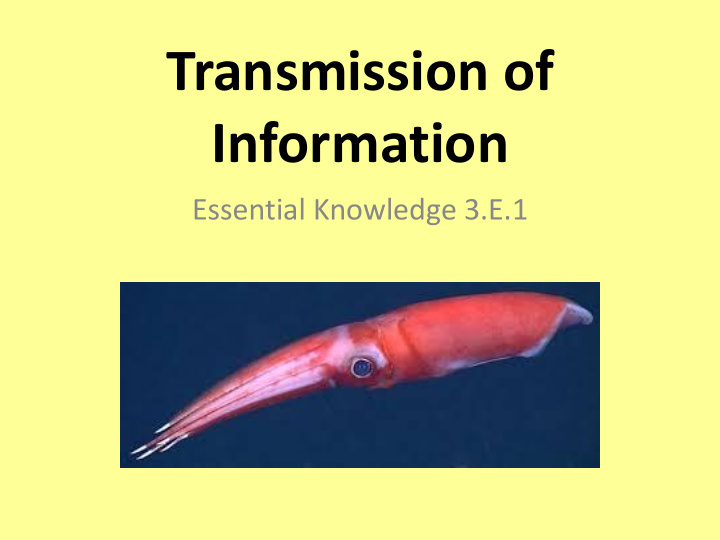



Transmission of Information Essential Knowledge 3.E.1
Individuals Can Act on Information and Communicate it to Others (Please watch this 10 min video and then proceed with notes) • Organisms exchange information with each other in response to internal changes and external cues , which can change behavior
Predator Warnings • Warning signal associated with the unprofitability of a prey item to potential predators • Example: Skunk spray
Predator Warnings • Bright colors serve as a warning to predators of its noxious taste (ex. poison dart frog) • Flamboyant or elaborate coloration may warn of toxicity (ex. cuttlefish)
Avoidance Responses • Animals will avoid performing behaviors that result in an aversive outcome • Avoidance responses are nearly universal in all animals because it is defense against potential poisoning (ex. food aversions)
Mimicry • Warning coloration is a successful strategy • Natural selection favors phenotypic mimics of genuinely aposematic (warning) organisms • Two types: Batesian and Mullerian mimicry
Communication Occurs Through Various Mechanisms • Living systems have a variety of signal behaviors or cues that produce changes in the behavior of other organisms and can result in differential reproductive success Examples: Territorial markings in mammals, herbivory response in plants
Herbivory Response in Plants • A plant’s defense against herbivores (animals who eat plants) • Physical defenses, such as thorns and trichomes (some release a sticky substance) • Chemical defenses, such as the production of a poor tasting or toxic chemical • Some plants “recruit” predatory animals that help defend the plant against herbivores
Herbivory Response in Plants
Visual, Audible, Tactile and Chemical Signals • Animals use visual, audible, tactile and chemical signals to indicate dominance, find food, establish territory and ensure reproductive success Examples: Pack behavior in wolves, waggle dance in honey bees, bird songs
Pack Behavior
Honeybee Waggle Dance
Herd, Flock and Schooling Behavior • Herd (quadripeds), flock (birds), and schooling (fish) behavior helps ensure reproductive success • Avoid predation, forage for food, appear as one unit, communicate information
Responding to Information and Communication of Information • Vital to natural selection and evolution • Natural selection favors innate and learned behaviors that increase survival and reproductive fitness Examples: Migration patterns, courtship and mating behaviors
Migration Patterns • Long distance movement of individuals, usually on a seasonal basis
Courtship and Mating Behaviors • Mating for most species is instinctual • Goal is to create offspring with strong genes
Responding to Information and Communication of Information • Cooperative behavior tends to increase the fitness of the individual and the survival of the population Examples: pack behavior, herd, flock and schooling, predator warning
Prairie Dog Warning Barks
Schooling Behavior
Recommend
More recommend